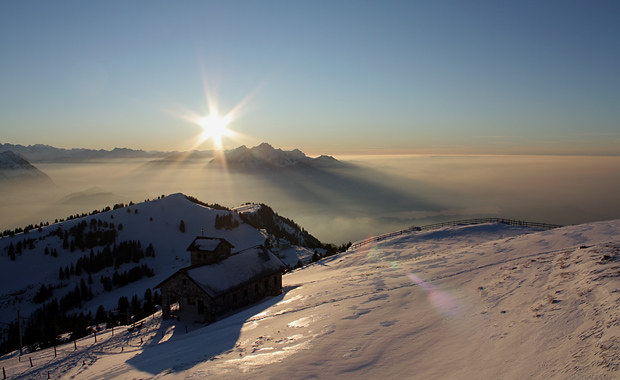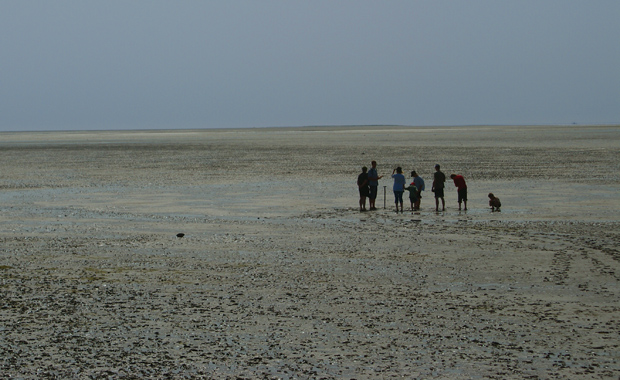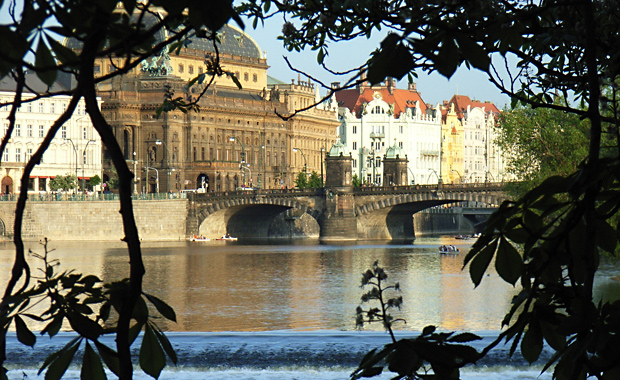Model Regions
The potential of a literary atlas of Europe will be demonstrated in the example of three differently endowed model regions: an Alpine landscape (Lake Lucerne/Gotthard in Switzerland), a coastal border area (North Friesland in Germany), and an urban space (Prague, Czech Republic). The literary permeation of these three spaces is examined within a time frame of about 250 years, from ca.1750 to the present. In a first step as much fictional texts as possible are being collected, set in one of these regions.
Lake Lucerne/Gotthard (Switzerland)
It can be said without overstatement: Lake Lucerne, and the encircling valleys and mountain peaks amongst which it is artfully inlaid, is demonstrably one of the capital regions on the map of European literature. As a geospatial totality, this region perfectly unifies the multiplicity of the Swiss landscape. There is a confluence of idyllic passages and lofty positions, attributable to the topographic situation of Lake Lucerne, in transition between midlands and high mountains. The farther south one goes in the direction of Gotthard, the more dramatic the landscape appears. The region thus contains the many particularities that make a geographic place a challenge to literature. This portion of geospace is connected with a virtually unbelievable catalogue of resonant names: Johann Wolfgang Goethe, Wilhelm Heinse, Friedrich Hölderlin, Heinrich Heine, Achim von Arnim, Friedrich Schiller, William Wordsworth, Alexandre Dumas, Sr., Alphonse Daudet, Leo Tolstoi, Fedor M. Dostojewski, Iwan Bunin, Mark Twain, Walter Scott, Mary Shelley, John Ruskin, James Fenimore Cooper, Johann Peter Hebel, D. H. Lawrence, Henry James, Samuel Butler, W. Somerset Maugham, Gustave Flaubert, Arthur Rimbaud, Jeremias Gotthelf, Gottfried Keller, August Strindberg, Hermann Hesse, Robert Walser, Carl Spitteler, Max Frisch, Elias Canetti.
North Friesland (Germany)
An amphibian landscape between water and land. With its repetitious swathe of marshlands, its peninsulas and islands, its scattered farms and few, small towns, the landscape of the west coast of Schleswig and Holstein is poor in physical differentiation but all the richer in cultural inscriptions. For centuries settled by Fresians, Danes, and Germans, (and the constant object of hostile border disputes), it is genuinely multilingual. Because of its remoteness and loneliness, this landscape, stretching from Ribe in the North to the Eiderstedt peninsula in the South, has ever since the eighteenth century been increasingly sought after, variously represented, and not infrequently utilised for ideological purposes. Ethnic and political conflicts culminated in the Danish-German folklore disputes of the nineteenth century, in which many native or local Danish, German, and bicultural authors were involved, from Sturmer und Dranger Heinrich Wilhelm von Gerstenberg and Heinrich Christian Boie to Theodor Mommsen, Friedrich Hebbel (from Dithmarschen) and naturally Theodor Storm – but also Hans Christian Andersen, who travelled this landscape and represented its cultural conflicts in one of his most important novels. The ill-fated Heimatkunst movement established itself here, in and against early Modernism, and found here a centre and a seemingly ideal contemplative object for its agitation. Here, too, the movement was effectively converted to Fascism, representatives of which saw in this landscape the realisation of the ideal German agrarian society. Conversely, after 1945 this landscape became on the one hand an exemplary European boundary region, and on the other hand the subject of an entirely new literature of the critique of civilisation, the retreat and subject matter for poets such as Sarah Kirsch, Siegfried Lenz, Günter Kunert et al, but also for Danish modernist poets (Peter Seeberg et al).
Prague (Czech Republic)
With the exception of Venice, scarcely any other middle-European city has produced a more powerful literary mythos than Prague. Claudio Magris depicts the city on the Moldau as a giant image dispenser. Tender fog, twilight, dusk, dreams, fairy tales, unreality, the romance of the morbid, the fantastic, the phantasmagorical, the demonic, a fondness for night, for the other side… Poets are the ones who have indelibly connected these images and expressions with the Czech capital. Meyrink speaks of the “demonic, uncanny magic of the city”; Franz Werfel characterises Prague as a “day-dream”, a “drug-rush” or “life's fata morgana” Oskar Wiener calls it “unspeakably beautiful, but wicked.” In the centre of the examination lies the system of the “Prague Text” and its topo-geographical dimension. It comprises texts that either explicitly or implicitly take Prague as their setting and thereby make a specific assertion about the city. It enables the topography of the city – of its individual buildings, residential streets, and quarters – to be reclaimed for itself through the centuries from very different interest groups, culminating in the flood of literary texts that appeared after 1989. This multiple coding of city space is not specific to Prague, but in this complex example, a “hot spot” of world literature, it can be particularly well measured.



